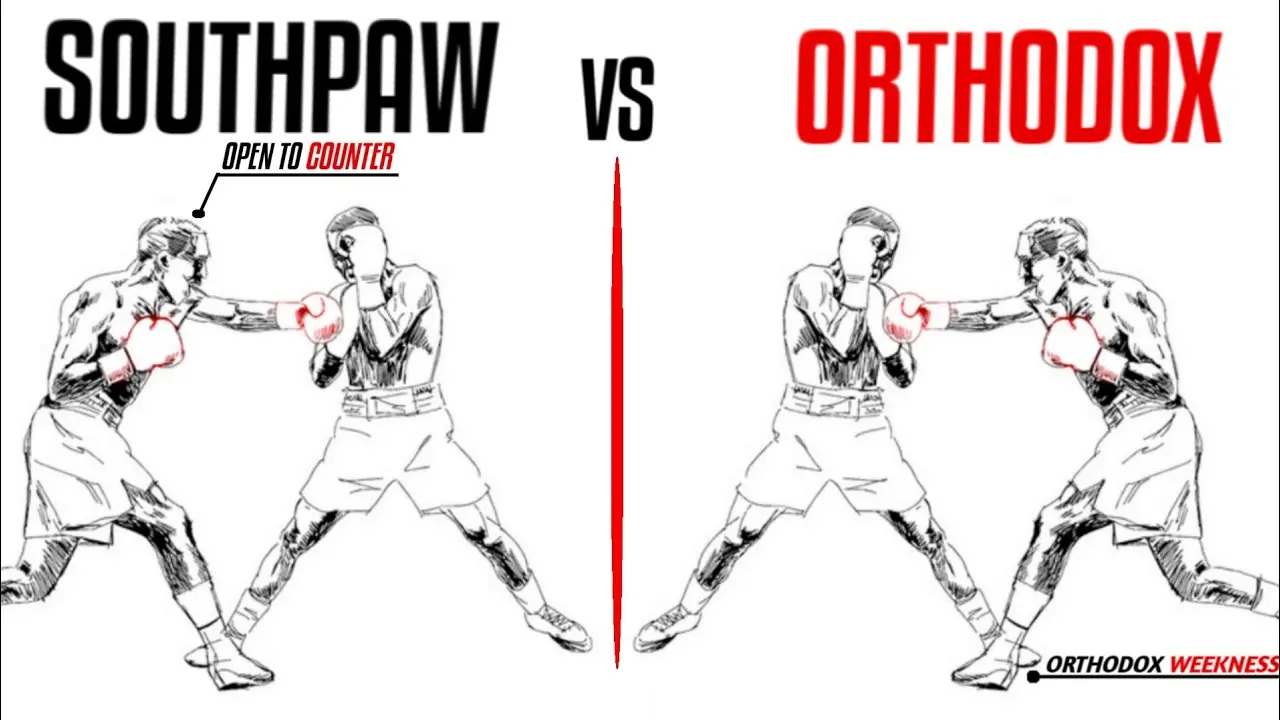Updated 25 June 2025, 11:00 BST
The debate around orthodox vs southpaw never goes out of fashion. From Usyk’s clashes with the best orthodox fighters such as Bellew, AJ twice and Fury twice, outclassing all 3 with his quick southpaw style. All the way to Floyd Mayweather’s orthodox performance to beat the great Manny Pacquiao. This article breaks down the fundamentals of each stance, the pros and cons, how one beats the other, and the best historical bouts.
What is the orthodox stance?
The orthodox stance is the most common stance used in boxing. It is when the boxer leads with the left foot and left hand, closest to the opponent. Both the right hand and foot stay to the rear and usually drive the power shots. Predominantly chosen by most right-handed fighters.
The key advantages are:
- Familiarity – opponents have seen it thousands of rounds.
- Liver-shot line – the left hook to the liver sits naturally against southpaws.
- Easier clockwise pivot keeps the fighter away from a left-handed power punch.
The key drawbacks are:
- Predictability – slick southpaws drill for orthodox looks.
- Exposed lead foot – a southpaw can step outside and line up the rear left.
What is the southpaw stance?
The southpaw stance is the least common stance used in boxing. It is when the boxer leads with the right foot and right hand, closest to the opponent. Both the left hand and foot stay to the rear and usually drive the power shots. Predominantly chosen by most left-handed fighters. Although still used by some clever right-handers who value the element of surprise, such as Marvin Hagler or Terence Crawford.
The key advantages are:
- Opponents see it less often – angles feel awkward.
- Straight left cross travels down the centre and splits an orthodox guard.
- Inside jab can smother an orthodox jab if the southpaw wins lead-hand control.
The key drawbacks are:
- Fewer elite southpaw sparring partners at heavyweight and above.
- Clockwise pivot is harder – pressure fighters can trap the exit route.

The switch-stance (aka “switch-hitter”)
A switch hitter is when a fighter can change lead foot mid-fight confusing the foot-position patterns and reset timing’s. Crawford popularised routinely starting orthodox before switching southpaw once he has got used to an opponent’s jab rhythm. The risk of the switch hitting stance is that foot-work errors leave you square-on and vulnerable.
Which stance wins more – and why?
A 340-boxer study of professionals across 17 weight classes found no significant difference in overall win-rate: 75 % of the group fought orthodox and 25 % southpaw. Each group scored roughly the same percentage of victories.
So why does the question still get asked, what is better, Orthodox or Southpaw?
- The Southpaw stance brings a rarity effect with it. Most fighters train and box in the orthodox stance so when a world class fighter is Southpaw such as Mcgregor or Usyk, it brings with it a rarity effect. Bringing a new style and match up that fans are less likely to be used to seeing.
- Style match-ups: Southpaws V Orthodox make for a great fight when one fighter struggles with one of the stances, such as the fight between Whyte V Itauma. Notoriously Whyte has struggled with southpaws, making this match up great for the younger boxer who is looking to make a name for himself in the top 10.
- Selection bias: The southpaws who reach the top have usually learned to thrive despite limited sparring partners, exaggerating their success. It is harder to become a world champion southpaw rather than a world champion orthodox fighter.
Famous fighter’s
Is Conor Mcgregor Orthodox or Southpaw?
Yes Connor is Southpaw – his famous cork-screw left hand was his money punch which landed him his 12 second knockout win over Jose Aldo.
Is Mike Tyson Orthodox or Southpaw?
Tyson fought orthodox, but he’s naturally left-handed, which is a rarity to see – the peek-a-boo system taught by Cus D’Amato put his stronger hand at the back for explosive hooks and uppercuts, which helped with his shorter height and fighting on the inside.
Are all right-handers orthodox?
No. Tyson, Oscar De La Hoya and Carl Frampton are naturally left-handed or ambidextrous yet fought orthodox for strategic reasons.
Are all left-handers southpaw?
No. Miguel Cotto and Andre Ward are left-hand dominant but chose orthodox because coaching and sparring are easier to find.
How do I know if I am Orthodox or Southpaw?
To determine if you are Orthodox or Southpaw, consider which foot you naturally place forward when standing in a fighting stance. If your left foot is forward, you’re likely Orthodox. If your right foot is forward, you’re likely Southpaw. Hand dominance can also be a helpful indicator, as most people naturally favor the stance that aligns with their dominant hand.
